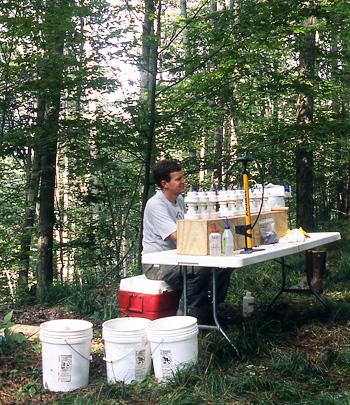Validating the Impact of Antagonistic Cations on Forest Health in the Northern Hardwood Ecosystem

Calcium is an important soil nutrient in healthy forests, but interactions with acid rain cause elements, such as aluminum, to interfere with calcium uptake by plants. Calcium-to-aluminum ratio in foliage and soil has been shown to be a predictor of tree health and is used in critical loads assessments to determine impacts of air pollution. Most studies have been done on greenhouse seedlings and have questionable application to mature forests. Another element, manganese, has also been shown to interfere with nutrient uptake.
NSRC researchers investigated these ratios in mature forest trees. They measured chemistry of soil, soil water, and foliage of sugar maple, yellow birch, white ash, and black cherry in 56 hardwood forest plots from Pennsylvania to New Hampshire. Researchers assessed tree health by rating tree canopies for dieback, transparency, and overall vigor. They measured stem diameter growth with increment cores.
Sugar maple was susceptible to decline and grew more slowly on soils with low concentrations of calcium and magnesium relative to aluminum and manganese. However, some sugar maple stands remained healthy even with low supplies of calcium and magnesium. Stands that experienced decline had both low ratios of nutrients to aluminum and manganese and history of stress, primarily from repeated insect defoliations. Black cherry showed contrasting behavior, generally growing best on sites with lowest calcium availability. Results for yellow birch and white ash were less clear. Findings suggest caution in use of calcium to aluminum ratios to assess forest health, as impacts are species specific and depend on cumulative effects of nutritional imbalances and secondary stresses.
